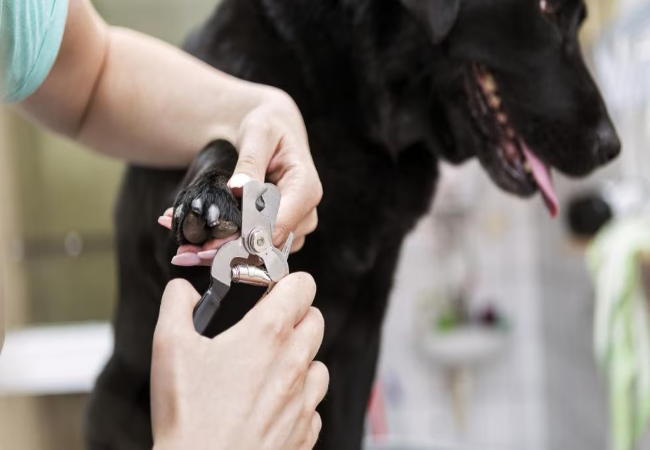Lupoid Onychodystrophy in Dogs 2025: Vet Backed Guide to Diagnosis, Treatment & Management🐾

In this article
Lupoid Onychodystrophy in Dogs 2025: Vet Backed Guide to Diagnosis, Treatment & Management🐾
By Dr. Duncan Houston BVSc
🔍 What Is Lupoid Onychodystrophy (SLO)?
Lupoid onychodystrophy—also called symmetrical lupoid onychitis—is an uncommon, immune‑mediated condition affecting a dog's nails. It typically causes dry, brittle, cracked nails across all four paws, often leading to nail loss and exposed sensitive nailbeds, which can be painful and prone to infection.
👣 Recognizing the Signs
- • Brittle, splitting nails that crack, thicken or deform
- • Nail loss—one or several nails that fall off, leaving exposed quick and tender paw exposed
- • Pain—limping, reluctance to bear weight, paw licking or chewing
- • Red, swollen toes if secondary bacterial infection occurs
- • Symmetrical impact: often affects same toes on each paw
🧬 Which Dogs Are at Higher Risk?
This immune‑mediated condition is believed to be hereditary, with most dogs showing signs between 2–8 years, though puppies and seniors can also be affected.
Breeds most commonly affected include German Shepherds, Rottweilers, Gordon Setters, though any breed can be impacted.
🧪 Diagnosing SLO
- Clinical signs + symmetrical nail loss suggest SLO
- Rule out other causes: bacterial/yeast infection, fungal, trauma, cancer
- Cytology and cultures detect infections
- X‑rays ensure bone health and rule out tumors
- Definitive diagnosis: biopsy of affected nail bed (often after sloughing or dewclaw amputation) for histopathology
💊 Treatment Protocols
While no cure exists, treatment aims to suppress immune response, manage pain, encourage nail regrowth, and prevent infection.
- • Omega‑3/6 fatty acids & Vitamin E – foundation of therapy; improve nail health and help modulate immunity
- • Tetracycline or doxycycline + niacinamide – immune‑modulating antibiotic combo
- • Pentoxifylline – reduces inflammation and improves circulation
- • Cyclosporine – powerful immune suppressant; effective but costly
- • Corticosteroids, azathioprine – for severe or refractory cases
- • Pain control – NSAIDs, tramadol during flares
- • Frequent nail trims every 1–2 weeks to prevent cracking
- • Antibiotics for secondary infections
- • Onychectomy (toe tip removal) for severely damaged digits in extreme cases
📈 Prognosis & Recovery
Therapy typically shows improvement in 3–4 months, though nail regrowth can take up to a year. Treatment is often lifelong to prevent relapses.
Studies comparing fish oil and cyclosporine show similar outcomes when combined with an omega-3-enriched diet, so fatty acids are an excellent first‑line option.
🏠 Long‑Term Management
- • Continue omega‑3/6 supplementation & Vitamin E
- • Trim nails every 1–2 weeks
- • Clean paws after walks and towards regrowth phases
- • Monitor for relapses—early treatment helps recovery
- • Regular vet checks for medication adjustment and symptom tracking
- • Treat concurrent conditions like hypothyroidism if present
🧸 Ask A Vet,
- 🩺 Ask A Vet: On‑demand vet advice to tailor treatment plans, monitor pain, and adjust immune therapy
📋 Quick Reference Table
| Goal | Recommended Action |
|---|---|
| Immune modulation | Omega‑3/6 + tetracycline/niacinamide ± cyclosporine |
| Bone & nail health | Vitamin E supplementation |
| Pain control | NSAIDs/tramadol during flares |
| Nail protection | Trim nails & clean paws frequently |
| Infection prevention | Topical cleans & systemic antibiotics as needed |
| Surgical relief | Onychectomy for painful refractory claws |
🎯 Final Thoughts
Lupoid onychodystrophy (SLO) is a painful, chronic immune‑mediated nail disease—but early detection, immune‑modulating treatment, diligent nail care, and pain control offer excellent quality of life and recovery potential. Most dogs respond well to omega‑3 + Vitamin E therapy, and when needed, medication intensification or surgical intervention. With long‑term management, your dog can stay active and comfortable.
— Dr Duncan Houston, BVSc
Need help creating a personalized SLO care plan? Visit AskAVet.com or download the Ask A Vet app for expert guidance anytime.






